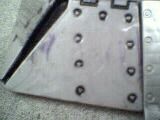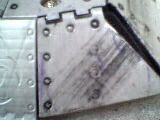Diesector
Pro Series
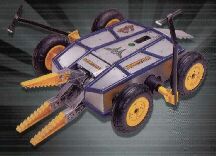
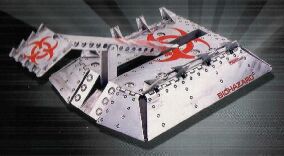
If you're like me, aside from being scrawny and weak, then you've always wanted to experience the thrill of driving a fighting robot. But you've been too intimidated by all the welding and motors and speed controllers and lacerations to build your own. Plus if you built anything heavier than a featherweight, you wouldn't be able to lift it, due to being so scrawny and weak.
Never fear, as the good folks at BattleBots, Inc. and Tiger Electronics have combined forces to bring you radio-controlled, small-scale replicas of robots seen on television for you to drive around and break things with.
The RC bots come in two flavors -- the Custom Series and the Pro Series. The Custom Series toys are smaller and less expensive. However, you can only control the wheels of the Custom Series -- they have no button for weapon control.
For twice the price of the Custom Series, you can get the Pro Series toys. These are larger than the Custom Series, and they also allow you to operate a weapon on each bot. Well, active weapons are what BattleBots is often about, right? So I made it my life's goal to own all of the Pro Series toys. Fortunately for me, there are only two, so it wasn't too hard to do.
The two Pro Series toys are BioHazard and Diesector. And unlike some of the Custom Series toys, they both closely resemble their namesakes. The proportions are a little off, but that's no big deal. You can immediately tell that you're dealing with BioHazard and Diesector. The only differences in appearance come from decals -- neither toy has its usual sponsor stickers, instead advertising BattleBots and Tiger Electronics. And like most every BattleBots toy made, they both have fake scrape and dirt marks all over the bodies. Why? I don't know. I guess the scars make the toys look tougher. I'll get more into visual discrepancies as I discuss each robot individually.
Each toy has three LED's on the top. This is the display of how much "virtual damage" your toy has received. If you hit your opponent in the right way on its side, "virtual damage" will register. If you get hit that way seven times, your bot automatically shuts itself off, meaning that you've lost. You press the green button next to the LED's to reset the damage meter. When I first heard about this feature, I was less than thrilled. But really, it's no big deal. It's very difficult to deliver seven strong enough hits to your opponent's side in a standard three-minute time period. The only problem seems to be that the aggressor in a fight usually has their lights go out more quickly than the one being pummeled. It takes a really big hit to make the "virtual damage" register, so you don't have to worry about moving backward two inches into a wall and turning off.
Both toys are made out of some really durable plastic. I have not been shy about running these at full speed into each other and even into cement walls, but the plastic armor hasn't broken on either toy (there appears to be a small crack starting to form in the front of BioHazard, but repeated poundings have yet to develop it).
The toys are driven tank style, as are the majority of all real BattleBots. In tank style driving, the wheels on each side of the toy are controlled separately. You press the left joystick forward or back, the left side of your toy moves forward or back. Same for the right side. You press both joysticks forward to make your bot move forward. Press the joysticks in opposite directions, and your bot spins in place. The toys are not sensitive to how far you press the joystick -- either it moves or it doesn't. This makes it a little more difficult to turn your toy while it's going forward at full speed.
The controller (i.e., transmitter) also has two buttons at the top. The button on the left controls the toy's weapon movement. The button on the right is an automatic "go straight forward" button. You use that button if you're not skilled enough to press two joysticks forward at the same time.
The controllers are a comfortable size; big enough for adult hands, but small enough for children's hands, too. If you want to know which controller controls which toy, though, you're going to have to look at the frequency sticker on the back, as there's no other identifying mark.
Each toy comes with a "special tool" (that's what they call it) that resembles the letter T. You use the bottom of this tool to turn the fasteners holding the adjustable parts of your toy and to turn the guards to keep your battery from falling out.
You can also have a BioHazard vs. BioHazard fight, or a Diesector vs. Diesector fight. Each toy comes with four channels (appropriately labeled A, B, C, and D). Just set each toy on a separate channel, and off you go. For the mathematically impaired, this means that you can have up to eight toys fighting simultaneously. Just make sure you know what pieces get knocked off of which one!
That's what the toys have in common. Now let's look at each toy individually.
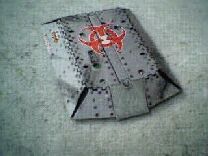 We'll start with BioHazard. BioHazard's shell measures roughly 13½ inches long by 10 inches wide. The skirts are not hinged -- they're simply part of the single solid shell. In addition, they ride a good ½ inch off the floor (this gives Diesector a fighting chance against BioHazard, I guess).
We'll start with BioHazard. BioHazard's shell measures roughly 13½ inches long by 10 inches wide. The skirts are not hinged -- they're simply part of the single solid shell. In addition, they ride a good ½ inch off the floor (this gives Diesector a fighting chance against BioHazard, I guess).
I was impressed that Tiger gave the toy BioHazard six wheels, just like the real BioHazard. I was not as impressed that the center wheel on each side is slightly lower than the others. All six wheels are motorized, but those center wheels are usually what do all the driving. This essentially turns BioHazard into a two-wheeled bot -- and we all know that two-wheeled bots are more difficult to drive than four-wheelers.
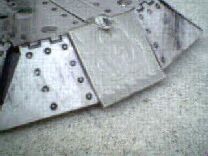
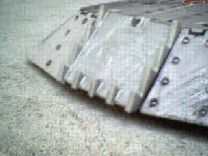
BioHazard comes with a choice of two prows for the lifting arm. One of the prows is pretty much like the real BioHazard's prow, smooth and with a subtle lip on the bottom, though the lip isn't pronounced enough to snag opponents (it also differs in that it has the biohazard symbol printed on it, but so what). The other prow has "teeth" along the bottom and both sides, which help it to snag the opponent. However, in practice, during a big collision, either prow will snap off the arm very easily, so the prow won't last long enough to make a difference.
 BioHazard also comes with what are described as "wedge guards," two long strips of plastic with four protrusions angled outward that can be "screwed" onto the top of BioHazard's body, one on each side. As best as I can tell, they're designed to keep robots from driving on top of BioHazard's body. But isn't that something you'd want your opponent to do? You can easily push them around when they do that (in fact, if the positioning is just right, Diesector can get high-centered on BioHazard's body, giving you a free chance to slam it into a wall).
BioHazard also comes with what are described as "wedge guards," two long strips of plastic with four protrusions angled outward that can be "screwed" onto the top of BioHazard's body, one on each side. As best as I can tell, they're designed to keep robots from driving on top of BioHazard's body. But isn't that something you'd want your opponent to do? You can easily push them around when they do that (in fact, if the positioning is just right, Diesector can get high-centered on BioHazard's body, giving you a free chance to slam it into a wall).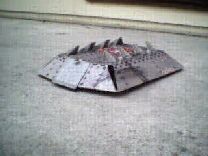 Here's my suggestion for the "wedge guards:" turn them around so they're facing the opposite way of the picture on the box. Now they're wedge extenders, giving BioHazard more wedge on its side for the opponent to drive up. And when the opponent goes up and over them, which usually happens, you've kind of snagged it, again allowing you to shove it around.
Here's my suggestion for the "wedge guards:" turn them around so they're facing the opposite way of the picture on the box. Now they're wedge extenders, giving BioHazard more wedge on its side for the opponent to drive up. And when the opponent goes up and over them, which usually happens, you've kind of snagged it, again allowing you to shove it around.
Now we get into the part that's not all that great -- the lifting arm. The arm does come out, and it does look like BioHazard's lift (though the real BioHazard's arm extends higher above its body). However, the arm is not very powerful, or even useful.
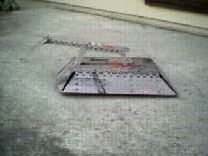 When you press the weapon button on your controller, BioHazard makes a loud whirring noise for a few seconds. Then its arm starts to rise from its body. The arm reaches its maximum height and holds there for a couple of seconds. After a twitch, the arm quickly snaps back into the body again. Apparently, this is "normal" behavior for the BioHazard toy, but it does make it difficult to time your attacks.
When you press the weapon button on your controller, BioHazard makes a loud whirring noise for a few seconds. Then its arm starts to rise from its body. The arm reaches its maximum height and holds there for a couple of seconds. After a twitch, the arm quickly snaps back into the body again. Apparently, this is "normal" behavior for the BioHazard toy, but it does make it difficult to time your attacks.
But it doesn't matter, because the arm really can't do much. The BioHazard toy doesn't have the power to flip another toy of its weight. I've tried to flip Diesector, but the best BioHazard can do is lift two of Diesector's wheels off the ground. When I try to push forward, BioHazard just stays in place and spins its wheels against the floor. So I don't think it's actually possible to flip another robot with BioHazard.
Also, if you put too much weight on the lifting arm, it won't come up at all. I put BioHazard on its back to see if it could self-right, but the arm didn't have enough power to even come out. When I got Diesector high-centered on me and tried to use the arm, it wouldn't extend under Diesector's weight. So when you consider the lack of power and the time it takes to get the arm to extend, BioHazard's arm isn't a very useful weapon in toy combat.
However, BioHazard still has some advantages. With its wedged sides and the fact that Diesector has a high ground clearance, BioHazard has the advantage in a fight, being able to shove Diesector around with ease. In a pushing match, BioHazard wins. For a change of pace, you might want to try pushing the joysticks in opposite directions. BioHazard will spin in place very quickly and can swat off a charging opponent.
Now, what fun is robotic combat without parts breaking off? As I said above, BioHazard's prow will inevitably snap off during a fight (if it doesn't, you're not being aggressive enough). Under the right circumstances, the "wedge guards" can become loose. And if you're foolish enough to drive around with the arm extended, it is possible for your opponent to hit you hard enough to snap the entire arm off (which looks really cool, but makes it difficult to win).
BioHazard is speedy, slightly difficult to control, and powerful. Its weapon is a bust, but that's the only drawback.
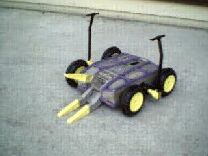 Now let's move on to Diesector. Diesector's main body measures roughly 9 inches long by 6¾ inches wide. Depending on where you measure from, the jaws are about 5 inches long. Each wheel sticks out of the side another couple of inches. The chisels stick out a little further, of course.
Now let's move on to Diesector. Diesector's main body measures roughly 9 inches long by 6¾ inches wide. Depending on where you measure from, the jaws are about 5 inches long. Each wheel sticks out of the side another couple of inches. The chisels stick out a little further, of course.
Diesector has all four wheels touching the ground at once, so it's easier to control than BioHazard. Should Diesector manage to get flipped (it's possible when Diesector and BioHazard both charge each other -- Diesector ramps up a wedged side and topples over. It looks really cool), it can run inverted, though the plastic armor doesn't extend to the belly of the robot. To control a flipped Diesector, just turn the controller upside-down in your hands.
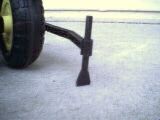 The weapon button on the controller only controls the jaws. The chisels (it's based on the season two Diesector, so it has chisels) move in relation to the forward motion of the wheels. As a set of wheels moves forward, the chisel on that side will slowly rise from the floor until it's perpendicular to the ground. Then it will suddenly snap forward, ideally hitting an opponent, but usually just smacking the ground. Even if they get knocked around, the chisels will somehow manage to get themselves back into their proper places. But since you can't control when the chisels drop, it's a matter of luck whether you hit anything (unless you're high-centered, in which case you can just gun the wheels forward and repeatedly let the chisels hit the opponent underneath). The chisels aren't powerful enough to make any kind of mark, but they look cool. More or less like the real Diesector.
The weapon button on the controller only controls the jaws. The chisels (it's based on the season two Diesector, so it has chisels) move in relation to the forward motion of the wheels. As a set of wheels moves forward, the chisel on that side will slowly rise from the floor until it's perpendicular to the ground. Then it will suddenly snap forward, ideally hitting an opponent, but usually just smacking the ground. Even if they get knocked around, the chisels will somehow manage to get themselves back into their proper places. But since you can't control when the chisels drop, it's a matter of luck whether you hit anything (unless you're high-centered, in which case you can just gun the wheels forward and repeatedly let the chisels hit the opponent underneath). The chisels aren't powerful enough to make any kind of mark, but they look cool. More or less like the real Diesector.
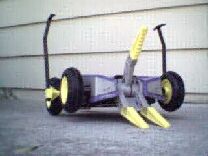 While on the real Diesector, each mandible is independently controlled, on the toy you only get the weapon button. When you press it, Diesector's jaws will cycle between wide open and almost shut. At their widest, the jaws will lift Diesector's front wheels off the ground (just like real life). You can drive around this way, but the toy has trouble moving with just the two wheels. You can also try to do the famous Diesector victory dance, but with the toy it's a little too slow, plus only one chisel will hit the ground (since the chisels don't react when you drive backward). If the jaws get knocked out of place, you can usually get them to reset themselves by cycling through the motions once (or by grabbing an object if you've managed to get them to overlap).
While on the real Diesector, each mandible is independently controlled, on the toy you only get the weapon button. When you press it, Diesector's jaws will cycle between wide open and almost shut. At their widest, the jaws will lift Diesector's front wheels off the ground (just like real life). You can drive around this way, but the toy has trouble moving with just the two wheels. You can also try to do the famous Diesector victory dance, but with the toy it's a little too slow, plus only one chisel will hit the ground (since the chisels don't react when you drive backward). If the jaws get knocked out of place, you can usually get them to reset themselves by cycling through the motions once (or by grabbing an object if you've managed to get them to overlap).
Diesector's jaws are designed to grasp, not crush. And of course, they're not strong enough to lift an opponent off of the ground. On the toy, they're really just for show -- it just looks like you're winning when you've got your jaws around an opponent.
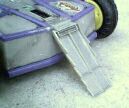 Diesector's "tail" is a simple piece of plastic that you snap onto the back once you get the toy out of the package. It's not as long proportionately as the real Diesector's tail, nor is the hinge flexible enough to just let the tail hang. When BioHazard gets under the back (and it will), the tail will just lift up into the air and stay that way, totally useless. It also won't flop down if you become inverted. But since you can't use it as a wedge anyway, it doesn't really matter where Diesector's tail is positioned.
Diesector's "tail" is a simple piece of plastic that you snap onto the back once you get the toy out of the package. It's not as long proportionately as the real Diesector's tail, nor is the hinge flexible enough to just let the tail hang. When BioHazard gets under the back (and it will), the tail will just lift up into the air and stay that way, totally useless. It also won't flop down if you become inverted. But since you can't use it as a wedge anyway, it doesn't really matter where Diesector's tail is positioned.
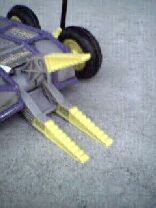
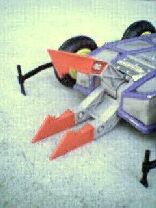 Diesector comes with alternate jaws that you can install instead of the traditional yellow ones. (Tip when changing the jaws -- the "special tool" doesn't fit in between the lower teeth. Slide one of the chisels through the open hole of the easy-to-change tooth to turn the fastener for the difficult-to-reach tooth to make things much easier.) As you can see, these red jaws have more of a "hook" to help you hold your opponent when you get underneath. However, the hook is so large that it's usually not possible to let go of your opponent once you've grabbed them, forcing a break in the action to separate the robots. They kind of take the fun out of capturing an opponent.
Diesector comes with alternate jaws that you can install instead of the traditional yellow ones. (Tip when changing the jaws -- the "special tool" doesn't fit in between the lower teeth. Slide one of the chisels through the open hole of the easy-to-change tooth to turn the fastener for the difficult-to-reach tooth to make things much easier.) As you can see, these red jaws have more of a "hook" to help you hold your opponent when you get underneath. However, the hook is so large that it's usually not possible to let go of your opponent once you've grabbed them, forcing a break in the action to separate the robots. They kind of take the fun out of capturing an opponent.
How do you fight with Diesector? Using the yellow jaws, the best strategy is to start at the point in the weapon's cycle where you've just lowered your front wheels back onto the ground, but the bottom jaw is still scraping the floor. That way you can get underneath your opponent, then lift the jaws so its side is lifted off the ground. Your opponent can still drive away on the wheels on the opposite side, but at least it'll have trouble doing so.
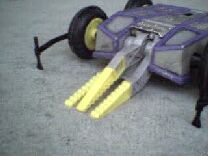 Normally, BioHazard can easily shove Diesector around due to Diesector's big wheels and BioHazard's wedged shape. However, if you apply some pressure to Diesector's upper jaw, you can force it down toward the floor, meeting with the lower jaw to form a wedge, just like the real Diesector often uses. This dramatically changes the fight, because now Diesector can get into that gap between BioHazard and the ground and push the robot around. Don't try to use the jaws to lift BioHazard while you're underneath, though -- they aren't powerful enough to lift an opponent. And you have to be careful, because once the wedge-jaws get knocked out of position, you can't get them back remotely. You'll have to go back to trying to clamp.
Normally, BioHazard can easily shove Diesector around due to Diesector's big wheels and BioHazard's wedged shape. However, if you apply some pressure to Diesector's upper jaw, you can force it down toward the floor, meeting with the lower jaw to form a wedge, just like the real Diesector often uses. This dramatically changes the fight, because now Diesector can get into that gap between BioHazard and the ground and push the robot around. Don't try to use the jaws to lift BioHazard while you're underneath, though -- they aren't powerful enough to lift an opponent. And you have to be careful, because once the wedge-jaws get knocked out of position, you can't get them back remotely. You'll have to go back to trying to clamp.
One of the most fun things about playing with the Diesector toy is the fact that it has plenty of parts that might break off. I challenge you to go a full three minutes without losing at least one of the chisel arms from the sides. The tail is a little more stubborn. It usually won't break off unless Diesector topples over backward on its rear end. And fortunately, since they're your only offense, the jaws are very sturdy (I've only had one of them snap off after an unusual collision).
Diesector is quick and more maneuverable than BioHazard. However, in a fight between the two toys, I'd expect BioHazard to win, because unless Diesector has its jaws in wedge mode, BioHazard will always be able to shove Diesector around. Of course, both toys are fun, and having working replicas of real BattleBots simply rocks. They're strong, sturdy, and fun. I recommend them.
(The preceding statements are strictly the author's opinion. I have received no compensation from any party, though, boy, I sure would be a great outlet to review early prototypes of any future Pro Series toys, wouldn't I?)
